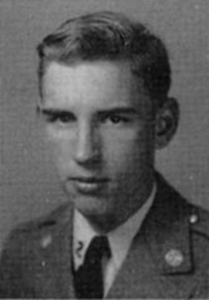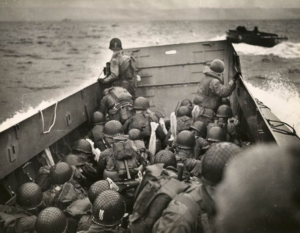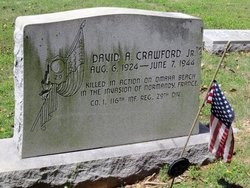Scroll of Honor – David Aiken Crawford, Jr.
“Defining Moment”
Written by: Kelly Durham
David Aiken Crawford, Jr. was the only child of Mr. and Mrs. David A. Crawford, Sr. of Winnsboro. In 1941, he graduated from Mount Zion Institute and matriculated at Clemson College. As a cadet, he was assigned to Company G, 2nd Battalion, 1st Regiment of the Cadet Brigade. His experience as a cadet would give him a leg up on the other young men he would soon encounter. At the end of the 1943 academic year with America’s military mobilization reaching high gear, most of Clemson’s cadets received their marching orders for Army basic training. David Crawford headed first to Fort McClellan, Alabama and then continued his training at Fort Meade, Maryland.
In January 1944, Crawford joined the hundreds of thousands of young Americans heading to Great Britain to join the buildup for the eventual invasion of France. Crawford was assigned to Company I, 116th Infantry Regiment, 29th Infantry Division. He could not have known it at the time, but his regiment was destined to land on Omaha Beach on D-Day.
From his arrival in England into the spring, Crawford and his comrades trained nearly continuously. Training advanced from individual and small unit tactics to operations in larger formations and included practice in loading aboard landing craft and making assault landings. Toward the end of May, the 116th, like other regiments participating in the initial landings, was sent to assembly areas in the south of England.
 The 116th was part of the great armada of warships of every size and purpose that sailed from ports stretched across England’s south coast, from Sheerness at the mouth of the Thames River in the east to Helford in the west. As the invasion fleet headed into the English Channel on June 5, 1944, the men in the ships were headed toward what General Eisenhower, the Allied Supreme Commander, called “the Great Crusade.”
The 116th was part of the great armada of warships of every size and purpose that sailed from ports stretched across England’s south coast, from Sheerness at the mouth of the Thames River in the east to Helford in the west. As the invasion fleet headed into the English Channel on June 5, 1944, the men in the ships were headed toward what General Eisenhower, the Allied Supreme Commander, called “the Great Crusade.”
David Crawford’s Company I was scheduled to hit Omaha Beach in D-Day’s second wave at 0720 hours, fifty minutes after the first troops stepped on to the sand. Crawford and his fellow soldiers were fed an early breakfast of Spam sandwiches and coffee and then ordered to their landing craft. At about 0430, they began boarding the boats, loaded down with personal gear and all the ammunition they could carry.
Once the boats were fully loaded, they pushed away from the transport ships and began to circle nearby, gathering all the boats into formation before heading out on the two hour, ten mile run into the landing beaches. As the second wave approached Omaha, roughly on schedule, they couldn’t know that elements of the first wave, also from the 116th Infantry Regiment, had received a hellish greeting. Company A, the first to land, had incurred ninety-six percent casualties, including all of its officers and sergeants. And no wonder: the invading troops were confronted by German defenses which “included minefields, barbed wire, antitank ditches, and interlocking bands of automatic fire” all concentrated at the exits from the beach which the Americans were attempting to capture.

An LCVP approaches Normandy on June 6, 1944 National World War II Museum
Crawford’s Company I arrived on a beach littered with dead and wounded soldiers, equipment, supplies, and vehicles, many of which had already been knocked out of action. Although the company’s seven LCVP landed on time, they hit the sand approximately one thousand yards to the left of Dog Red, their assigned sector of the beach in front of the village of Les Moulins. The company landed instead on Easy Green–but there was nothing easy about it. After the punishing ride in from the transports in the wallowing, wave-bucking, flat-prow landing craft, most of the men were already exhausted from seasickness, the heavy weight of weapons, ammunition, and equipment, and the cacophonous racket of friendly and enemy shells streaking overhead—and landing all too close. Not to mention fear.
Despite the violent inferno, despite the slaughter on the beach and the confusion and helplessness of battle, Company I attacked and by noon on that agonizing day had fought its way off the beach and onto the plateau above. By midday, Company I had moved inland one half mile along the road leading toward St. Laurent.
By the end of D-Day, the Allies had gained a foothold in France, one they would continue to expand over the weeks to come. But the Germans were not finished. They continued to resist and to counterattack. On June 7, Private First Class David Crawford was killed in action. He was laid to rest in the American Military Cemetery at Colleville on the picturesque bluff overlooking Omaha Beach. After the war, Crawford’s remains were returned to Winnsboro and buried at the Bethel ARP Church.
Historian Stephen Ambrose called D-Day the “defining moment of the 20th Century.” Omaha Beach, in the center of the invasion frontage, was a narrowly-won victory. Nothing went according to plan and in the end, Ambrose wrote, “It all came down to a bunch of eighteen-to-twenty-eight year olds… when the test came, when freedom had to be fought for or abandoned, they fought. They were soldiers of democracy. They were the men of D-Day, and to them we owe our freedom.”
 For more information about Private First Class David Aiken Crawford, Jr. see:
For more information about Private First Class David Aiken Crawford, Jr. see:
https://soh.alumni.clemson.edu/scroll/david-aiken-crawford-jr/
For additional information about Clemson University’s Scroll of Honor visit:
https://soh.alumni.clemson.edu/
See also D-Day June 6, 1944: The Climactic Battle of World War II, by Stephen Ambrose, Touchstone Books, 1994.
